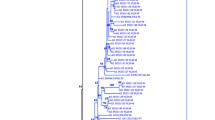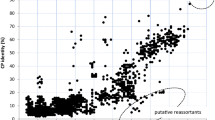Abstract
The human polyomavirus BK virus (BKV) is ubiquitous in humans, infecting children asymptomatically. BKV is the only primate polyomavirus that has subtypes (I–IV) distinguishable by immunological reactivity. Nucleotide (nt) variations in a major capsid protein (VP1) gene region (designated the epitope region), probably responsible for antigenic diversity, have been used to classify BKV isolates into subtypes. Here, with all the protein-encoding gene sequences, we attempted to elucidate the evolutionary relationships among 28 BKV isolates belonging to subtypes I, III, and IV (no isolate belonging to subtype II, a minor one, was included). First, using the GTR + Γ + I model, maximum likelihood trees were reconstructed for individual viral genes as well as for concatenated viral genes. On the resultant trees, the 28 BKV isolates were consistently divided into three clades corresponding to subtypes I, III, and IV, although bootstrap probabilities are not always high. Then we used more sophisticated likelihood models, one of which takes account of codon structure, to elucidate the phylogenetic relationships among BKV subtypes, but the phylogeny of the deep branchings remained ambiguous. Furthermore, the possibility of positive selection in the evolution of BKV was examined using the nonsynonymous/synonymous rate ratio as a measure of selection. An analysis based on entire genes could not detect any strong evidence for positive selection, but that based on the epitope region identified a few sites potentially under positive selection (these sites were among those showing subtype linked polymorphisms).



Similar content being viewed by others
References
Agostini HT, Brubaker GR, Shao J, Levin A, Ryschkewitsch CF, Blattner WA, Stoner GL (1995) BK virus and a new type of JC virus excreted by HIV-1 positive patients in rural Tanzania. Arch Virol 140:1919–1934
Akaike H (1974) A new look at the statistical model identification. IEEE Trans Aut Cont 19:716–723
Baksh FK, Finkelstein SD, Swalsky PA, Stoner GL, Ryschkewitsch CF, Randhawa P (2001) Molecular genotyping of BK and JC viruses in human polyomavirus-associated interstitial nephritis after renal transplantation. Am J Kidney Dis 38:354–365
Cantalupo P, Doering A, Sullivan CS, Pal A, Peden KWC, Lewis AM, Pipas JM (2005) Complete nucleotide sequence of polyomavirus SA12. J Virol 79:13094–13104
Chauhan S, Lecatsas G, Harley EH (1984) Genome analysis of BK (WW) viral DNA cloned directly from human urine. Intervirology 22:170–176
Chen Y, Sharp PM, Fowkes M, Kocher O, Joseph JT, Koralnik IJ (2004) Analysis of 15 novel full-length BK virus sequences from three individuals: evidence of a high intra-strain genetic diversity. J Gen Virol 85:2651–2663
Chesters PM, Heritage J, McCance DJ (1983) Persistence of DNA sequences of BK virus and JC virus in normal human tissues and in diseased tissues. J Infect Dis 147:676–684
Cole CN, Conzen SD (2001) Polyomaviridae: the viruses and their replication. In: Knipe DM, Howley PM (eds) Fields virology, 4th ed. Lippincott Williams & Wilkins, Philadelphia, pp 2141–2173
Coleman DV, Wolfendale MR, Daniel RA, Dhanjal NK, Gardner SD, Gibson PE, Field AM (1980) A prospective study of human polyomavirus infection in pregnancy. J Infect Dis 142:1–8
Cunningham TP, Pipas JM (1985) Simian agent 12 is a BK virus-like papovavirus which replicates in monkey cells. J Virol 54:483–492
Dayhoff MO, Schwartz RM, Orcutt BC (1978) A model of evolutionary change in proteins. In: Dayhoff MO (ed) Atlas of protein sequence and structure, Vol 5, Suppl 3. National Biomedical Research Foundation. Washington DC, pp 345–352
de Bruyn G, Limaye AP (2004) BK virus-associated nephropathy in kidney transplant recipients. Rev Med Virol 14:193–205
Di Taranto C, Pietropaolo V, Orsi GB, Jin L, Sinibaldi L, Degener AM (1997) Detection of BK polyomavirus genotypes in healthy and HIV-positive children. Eur J Epidemiol 13:653–657
Felsenstein J (1981) Evolutionary trees from DNA sequences: a maximum likelihood approach. J Mol Evol 17:368–376
Felsenstein J (1985) Confidence limits on phylogenies: An approach using the bootstrap. Evolution 39:783–791
Gardner SD, Field AM, Coleman DV, Hulme B (1971) New human papovavirus (B.K.) isolated from urine after renal transplantation. Lancet 1:1253–1257
Goldman N, Yang Z (1994) A codon-based model of nucleotide substitution for protein-coding DNA sequences. Mol Biol Evol 11:725–736
Goudsmit J, Baak ML, Sleterus KW, Van der Noordaa J (1981) Human papovavirus isolated from urine of a child with acute tonsillitis. Br Med J (Clin Res Ed). 283:1363–1364
Grantham R (1974) Amino acid differences formula to help explain protein evolution. Science 185:862–864
Hasegawa M, Kishino H (1994) Accuracies of the simple methods for estimating the bootstrap probability of a maximum likelihood tree. Mol Biol Evol 11:142–145
Hasegawa M, Cao Y, Yang Z (1998) Preponderance of slightly deleterious polymorphism in mitochondrial DNA: nonsynonymous/synonymous rate ratio is much higher within species than between species. Mol Biol Evol 15:1499–1505
Hasegawa M, Thorne JL, Kishino H (2003) Time scale of eutherian evolution estimated without assuming a constant rate of molecular evolution. Genes Genet Syst 78:267–283
Heritage J, Chesters PM, McCance DJ (1981) The persistence of papovavirus BK DNA sequences in normal human renal tissue. J Med Virol 8:143–150
Howley PM, Khoury G, Byrne JC, Takemoto KK, Martin MA (1975) Physical map of the BK virus genome. J Virol 16:959–973
Hughes A (1999) Adaptive evolution of genes and genomes. Oxford University Press, New York
Jin L (1993) Rapid genomic typing of BK virus directly from clinical specimens. Mol Cell Probes 7:331–334
Jin L, Gibson PE, Knowles WA, Clewley JP (1993a) BK virus antigenic variants: sequence analysis within the capsid VP1 epitope. J Med Virol 39:50–56
Jin L, Gibson PE, Booth JC, Clewley JP (1993b) Genomic typing of BK virus in clinical specimens by direct sequencing of polymerase chain reaction products. J MedVirol 41:11–17
Jin L, Pietropaolo V, Booth JC, Ward KH, Brown DW (1995) Prevalence and distribution of BK virus subtypes in healthy people and immunocompromised patients detected by PCR-restriction enzyme analysis. Clin Diag Virol 3:285–295
Kimura M (1983) The neutral theory of molecular evolution. Cambridge University Press, Cambridge
Kishino H, Hasegawa M (1989) Evaluation of the maximum likelihood estimate of the evolutionary tree topologies from DNA sequence data, and the branching order in hominoidea. J Mol Evol 29:170–179
Kishino H, Hasegawa M (1990) Converting distance to time: application to human evolution. Methods Enzymol 183:550–570
Kishino H, Miyata T, Hasegawa M (1990) Maximum likelihood inference of protein phylogeny and the origin of chloroplasts. J Mol Evol 30:151–160
Kishino H, Thorne JL, Bruno WJ (2001) Performance of a divergence time estimation method under a probabilistic model of rate evolution. Mol Biol Evol 18:352–361
Knowles WA (2001) The epidemiology of BK virus and the occurrence of antigenic and genomic subtypes. In: Khalili K, Stoner GL (eds) Human polyomaviruses: Molecular and clinical perspectives. John Wiley & Sons, New York, pp 527–559
McLachlan AD (1971) Tests for comparing related amino-acid sequences. Cytochrome c and cytochrome c551. J Mol Evol 61:409–424
Milne I, Wright F, Rowe G, Marshall DF, Husmeier D, McGuire G (2004) TOPALi: software for automatic identification of recombinant sequences within DNA multiple alignments. Bioinformatics 20:1806–1807
Miyata T, Yasunaga T (1980) Molecular evolution of mRNA: a method for estimating evolutionary rates of synonymous and amino acid substitutions from homologous nucleotide sequences and its applications. J Mol Evol 16:23–36
Miyata T, Miyazawa S, Yasunaga T (1979) Two types of amino acid substitutions in protein evolution. J Mol Evol 12:219–236
Nielsen R, Yang Z (1998) Likelihood models for detecting positively selected amino acid sites and applications to the HIV-1 envelope gene. Genetics 148:929–936
Ohta T (1992) The nearly neutral theory of molecular evolution. Annu Rev Ecol Syst 23:263–286
Pauw W, Choufoer J (1978) Isolation of a variant of BK virus with altered restriction endonuclease pattern. Arch Virol 57:35–42
Posada D, Crandall KA (1998) MODELTEST: testing the model of DNA substitution. Bioinformatics 14:817–818
Pupko T, Sharan R, Hasegawa M, Shamir R, Graur D (2003) Detecting excess radical replacements in phylogenetic trees. Gene 319:127–135
Rodriguez F, Oliver JL, Marin A, Medina JR (1990) The general stochastic model of nucleotide substitution. J Theor Biol 142:485–501
Sasaki T, Nikaido M, Hamilton H, Goto M, Kato H, Kanda N, Pastene LA, Cao Y, Fordyce RE, Hasegawa M, Okada N (2005) Mitochondrial phylogenetics and evolution of Mysticete whales. Syst Biol 54:77–90
Seif I, Khoury G, Dhar R (1979) The genome of human papovavirus BKV. Cell 18:963–977
Stoner GL, Hübner R (2001) The human polyomaviruses: past, present, and future. In: Khalili K, Stoner GL (eds) Human polyomaviruses: Molecular and clinical perspectives. John Wiley & Sons, New York, pp 127–148
Sugimoto C, Hara K, Taguchi F, Yogo Y (1989) Growth efficiency of naturally occurring BK virus variants in vivo and in vitro. J Virol 63:3195–3199
Sugimoto C, Hasegawa M, Kato A, Zheng HY, Ebihara H, Taguchi F, Kitamura T, Yogo Y (2002) Evolution of human polyomavirus JC: implications for the population history of humans. J Mol Evol 54:285–297
Swofford DL (2003) PAUP*: Phylogenetic Analysis Using Parsimony (*and other methods), version 4.0b10. Sinauer Associates, Sunderland, MA
Takasaka T, Goya N, Tokumoto T, Tanabe K, Toma H, Ogawa Y, Hokama S, Momose A, Funyu T, Fujioka T, Omori S, Akiyama H, Chen Q, Zheng HY, Ohta N, Kitamura T, Yogo Y (2004) Subtypes of BK virus prevalent in Japan and variation in their transcriptional control region. J Gen Virol 85:2821–2827
Tavis JE, Walker DL, Gardner SD, Frisque RJ (1989) Nucleotide sequence of the human polyomavirus AS virus, an antigenic variant of BK virus. J Virol 63:901–911
Thorne JL, Kishino H, Painter IS (1998) Estimating the rate of evolution of the rate of molecular evolution. Mol Biol Evol 15:1647–1657
Valis JD, Newell N, Reissig M, Malherbe H, Kaschula VR, Shah KV (1977) Characterization of SA12 as a simian virus 40-related papovavirus of chacma baboons. Infect Immun 18:247–252
Yamaguchi-Kabata Y, Gojobori T (2000) Reevaluation of amino acid variability of the human immunodeficiency virus type 1 gp120 envelope glycoprotein and prediction of new discontinuous epitopes. J Virol 74:4335–4350
Yang RC, Wu R (1979) BK virus DNA: complete nucleotide sequence of a human tumor virus. Science 206:456–462
Yang W, Bielawski JP, Yang Z (2003) Widespread adaptive evolution in the human immunodeficiency virus type I genome. J Mol Evol 57:212–221
Yang Z (1996) Among-site rate variation and its impact on phylogenetic analyses. TREE 11:367–372
Yang Z (1997) PAML: a program package for phylogenetic analysis by maximum likelihood. CABIOS 13:555–556
Yang Z (1998) Likelihood ratio tests for detecting positive selection and application to primate lysozyme evolution. Mol Biol Evol 15:568–573
Yang Z (2000) Maximum likelihood estimation on large phylogenies and analysis of adaptive evolution in human influenza virus A. J Mol Evol 51:423–432
Yang Z, Bielawski JP (2000) Statistical methods for detecting molecular adaptation. TREE 15:496–503
Yang Z, Nielsen R, Hasegawa M (1998) Models of amino acid substitution and applications to mitochondrial protein evolution. Mol Biol Evol 15:1600–1611
Yang Z, Wong WSW, Nielsen R (2005) Bayes empirical Bayes inference of amino acid sites under positive selection. Mol Biol Evol 22:1107–1118
Yogo Y, Iida T, Taguchi F, Kitamura T, Aso Y (1991) Typing of human polyomavirus JC virus on the basis of restriction fragment length polymorphisms. J Clin Microbiol 29:2130–2138
Yogo Y, Sugimoto C, Zheng HY, Ikegaya H, Takasaka T, Kitamura T (2004) JC virus genotyping offers a new paradigm in the study of human populations. Rev Med Virol 14:179–191
Acknowledgments
We are grateful to all urine donors. We thank Drs. N. Goya, Y. Ogawa, A. Momose, T. Fujioka, and H. Akiyama for providing urine samples and Drs. J. van der Noordaa and R. Rubinstein for providing BKV DNA clones. This study was supported in part by grants from the Ministry of Health, Labor and Welfare, Japan, from the Japan Society for the Promotion of Science, and from TRIC, Research Organization of Information and Systems.
Author information
Authors and Affiliations
Corresponding author
Additional information
These author Yuriko Nishimoto and Tomokazu Takasaka contributed equally to this article.
[Reviewing Editor: Dr. Rasmus Nielsen]
Rights and permissions
About this article
Cite this article
Nishimoto, Y., Takasaka, T., Hasegawa, M. et al. Evolution of BK Virus Based on Complete Genome Data. J Mol Evol 63, 341–352 (2006). https://doi.org/10.1007/s00239-005-0092-5
Received:
Accepted:
Published:
Issue Date:
DOI: https://doi.org/10.1007/s00239-005-0092-5




